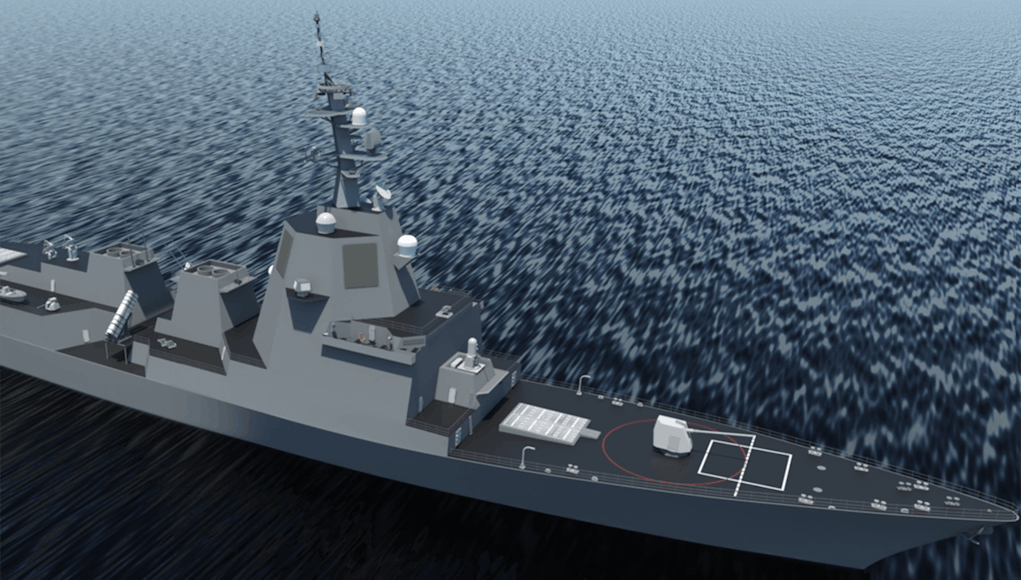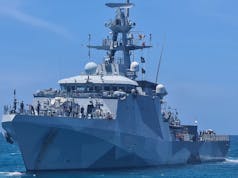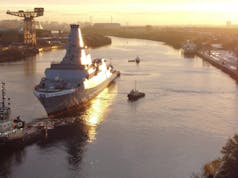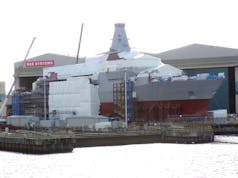Lockheed Martin successfully demonstrated the first live track AN/SPY-7(V)1 radar for the Aegis System Equipped Vessel (ASEV), marking a critical milestone in the programme.
During the first track event, SPY-7 radar tactical hardware and software tracked objects in space, which verified the maturity of the radar system and marked the beginning of comprehensive performance testing.
“We use our proven integration and test process to fully test the capability of Aegis and SPY-7 prior to delivery to Japan,” said Amr Hussein, vice president of Multi-Domain Combat Solutions at Lockheed Martin.
“This vigorous testing regimen minimizes risk and ensures that Japan will receive a fully integrated and calibrated system as quickly as possible.”
The Japan Ministry of Defence will field two ASEVs with the SPY-7 radar system.
“The SPY-7 radar product line uses technology from the Long Range Discrimination Radar (LRDR) program to enhance overall strength against evolving threats,” said Chandra Marshall, vice president of Radar and Sensor Systems at Lockheed Martin. “Providing 24/7 coverage, SPY-7 is a superior deterrence asset available for land and maritime applications around the world.”
The tracking event was performed at Lockheed Martin’s Production Test Center in Moorestown, New Jersey. The SPY-7 radar system and Aegis Weapon System equipment will be fully tested ahead of the shipment to Japan.














https://youtu.be/gBhJTemSKaA?si=q4g7g_1qWvc7TImM
Missile Defense Agency video on the LRDR, where the SPY-7 came from.
An in-depth article on the War Zone from 2 April, is a good companion to George’s item above.
Back in 2006 a SMART-L radar aboard a Dutch Zeven Provincien class frigate already successfully tested tracking of missiles in space. Aren’t the Americans a bit late on this subject?
The old SPY-1 on Arleigh Burkes and has been able to track missiles in space and discriminate clutter for a long time now.
This is a new AESA radar, the SPY-7 that is undergoing testing. The Japanese, Canadians, and Spanish are going to use it on ships. The US uses it in the ground based Long Range Discrimination Radar, as the article states.
Apparently SPY-7 lost out in USN testing to the SPY-6, which is has recently entered service.
Isn’t the SPY-6 also designed to be a drop in replacement for SPY-1? USN has a lot of SPY-1 based AB destroyers they may want to upgrade & new AB’s are still being built. The others appear to be looking at SPY-7 on new build new design ships.
SPY-6 is the US Navy’s new radar of choice. It will be installed on several ship types in 4 different versions. Flight III Burkes will get the big (V)1, Flight IIA Burkes will get the mid-sized (V)4, Amphibious ships and Nimitz class carriers will get the small, rotating (V)2, and Ford class carriers and Constellation class frigates will get the (V)3. The first (V)1 is in active service on USS Jack H. Lucas and the first (V)2 rotating version has already been installed on the new USS Richard M. McCool (LPD-29). The USN isn’t planning to use the SPY-7, they are competing designs using similar tech, but the USN chose SPY-6.
That is correct. Some brilliant Thales engineers had the idea the radar’s range could be spectacularly extended without needing more power by tweaking the software. This ultimately led to the development of the SMART-L MM/N radar, which the De Zeven Provinciën class currently uses.
I think that radar is also AESA whereas our S1850 is PESA, giving more power.
The smart-L is a generation behind the SPY-6 and 7. It’s closer in performance to SPY-1.
Doesn’t this imply that the 1850 radar, which is older than the Smart-L MM/N, on the type 45’s is close to obsolete?
You have to be careful about saying that based on the installed model.
There are so many upgrade steps and RN are being very cagey about what is upgraded radar wise ATM.
T45 has also demonstrated the ability to track space and high ballistic objects.
Radar sensitivity is mostly down to receiver and software. You can be pretty sure that the software has been upgraded the receiver maybe…..or maybe it is a larger part of the T45 upgrade plan?
Thales had to sell RN TACTICOS for T31 and I’d be surprised is 1850 upgrades were not in the table at the same time….maybe not…..that is what I’d do!
I agree the back end software and tweaking and displaying of information through it is often the secret to fully exploiting the capabilities of the actual physical Antenna.
My understanding the new SMART-L MM/N is one of new generation of radars fitted world wide to nearly all new Navy ships that use the GaN T/R module radars which replacing the older generation GaAs radars, GaN can take five times the power of GaAs with five times the R/F energy produced for increased range or better discrimination. The four French and Italian Horizon MLU includes replacing the SMART-L S1850 with the SMART-L MM/N. Remember reading even the Hensoldt (Kelvin Hughes) navigational radar SharpEye now fitted with GaN.
Discrimination is especially vital for distinguishing between ballistic missile decoys and their warhead, the Russian Iskander has six decoys that are ejected from base of missile to confuse both the radar and interceptor missiles.
I think the S1850M/SMART-L, should be a generation ahead of the SPY-1, both are AESA versus the SPY-1 which is PESA tech. They’d be a generation behind the GaN radars like the SPY-6/SPY-7 or SMART-L MM/N. All should be capable of detecting and tracking large ballistic missiles in space.
I expect the SMART-L MM/N to proffer a longer range and better stealth target detection than the SPY-6/SPY-7 solely because it’s an L-band radar. She’s a dedicated LRR meant to be paired with an MFR like the SAMPSON/EMPAR, whereas the SPY series are sort of mixed MFR/LRR radars.
For range claims:
SPY-1D(V) – 310km for a ballistic missile sized target
SAMPSON – out to around 400km
S1850M – out to around 400km, 2000km with upgrade
SMART-L – out to around 400km, 2000km with upgrade
SPY-6 – claimed 3x longer range than SPY-1. Expect 1230km for the V4 variant to be retrofitted to the Arleigh Burke Flight IIA, or 1848km for the V1 variant to be fitted to the Arleigh Burke Flight III.
Just out of curiosity, what type of radar is at RAF Fylingdales? And you don’t have to give away too many secrets. 😆 Is it a similar type to any of these SPY type radars just much larger?
Don’t know what’s there now but the UK is getting the LRDR (long Range Discrimination Radar) which the SPY-7 reportedly is a derivative of.
https://www.janes.com/defence-news/news-detail/uk-approved-to-buy-ballistic-missile-defence-radar
Fylingdales uses the AN/FPS-132 made by Raytheon. It replaced the previous radars housed in the “golf balls”. This is a 360 degree field of view radar, that uses three antenna arrays fitted to a three sided pyramid. It is an AESA radar that operates in the UHF band.
Although it can and does identify and track aircraft. Its main function is to search for and identify ICBM/MRBMs. It’s published detection range for detecting space based targets is 3000 miles.
The SPY 6 operates in the L-band, whilst the SPY-7 operates in the higher S-band. There are pros and cons for a ship. Basically due to the antenna array area size, you generally wouldn’t use UHF radar from a ship. For maximum efficiency the antenna would need to be huge. Imagine a SPY-1 array on an Arleigh Burke, then adding another 1/2 to 1/3 in area. This would also seriously up the weight the ship would need to house and carry.
The next frequency band up from UHF is L. This is the 1 to 2 GHz band. It can produce speculative reflections from a target as per UHF. Which is good for spotting targets with very small radar cross sections. But can also produce a narrower beam due to the smaller wavelength. It can produce target tracking information. But due to the width of the beam, it isn’t very accurate.
The Lockheed Martin SPY-7 operates in the higher S-band (2 to 4 GHz). This is the same as the T45’s BAe Sampson radar. S-band is a good compromise between power efficiency and target resolution. Again, as its wavelength is smaller than the previous L-band, it can produce a narrower beam. This is good enough for target tracking information. Though still not as accurate as what is needed for missiles using semi active radar homing, which normally uses the much higher X-band (8 to 12 GHz).
In summary the radar type used at Fylingdales is much too large to fit to a ship.
Thanks Davey for another brilliant reply! You’re an absolute education! I read that the S1850 on the T45s is an L band and more for long range searching.
Bit of a silly question and you don’t need to tell any state secrets. This is taking my GBAD rant on a bit of a tangent, but a site like Fylingdales would hopefully be able to defend itself electronically at least to some degree? It’s a bloody great strategic target 🎯. Any backup? Wouldn’t having two such sites be better for the UK even if it’s twice the use of electricity? None this is any of my business but this site (and others) must be in the sights of “our friends” over the fence. I guess all fixed radar and communications sites are potentially vulnerable to missiles, drones, sabotage.
In theory any radar has the capability of performing electronic warfare. A lot will depend on the effective radiated power of the radar, the type of waveform being used, but also the cross sectional area of the beam applied to the target.
A radar that uses electronic beam forming will have a distinct advantage over a radar using either a parabolic or planar antenna. As more energy is transmitted in the main lobe of the beam. But with AESA in particular, there are less side lobes being generated, so again more power in the main lobe.
AESA having incredibly fast beam sweeping, means it should be able to keep the target illuminated, even if it’s doing radical maneuvering.
I can’t answer the question on whether the radar at Fylingdales, or if the T45’s S1850M and Sampson can be used for EW! As that would deny/confirm an operational capability. But it is well known not to fly an aircraft close to a T45, when it’s operating its primary radar. I think it was HMS Duncan, that warned the Russian aircraft when it was sailing past Crimea. Don’t fly too close or your aircraft may be affected by the ship’s radars.
You are completely correct in saying a fixed radar site is vulnerable to enemy surprise attack. If a conflict was known to be coming you would like to think primary assets, such as Fylingdales would be protected. As far as back ups go. The RAF’s Idra Lanza radar is likely to take on a lot of this role, if not being deployed abroad. There are a number of other 3D radars used by the RAF around the country that are semi-permanent. Where they could be moved to a new location if required.
If the RAF didn’t use the 2 spare radars it has from the purchase of 5 wedge tail kits could they find a sea/land function? I hope they just buy two more planes and attach them there but just asking.
And it would be good get this done before they may be needed! 😁
Yes it could do. But they won’t be operating at their maximum efficiency unless some modifications are made.
The Wedgetail uses the Northrop Grumman Multi-role Electronically Scanned Array (MESA) radar. This is an AESA radar operating in the L-band (1 to 2 GHz). The radar is fitted to a fin on top of a B737 fuselage. Where the “main” arrays are mounted either side of the upright fin. It also puts transmitter-receiver modules (TRMs) in the front and rear of the top fairing. Thus giving a 360 degree field of view.
The front and rear antenna array is much smaller than the sides. So its range and resolution will be less. As the radar is on the ground, to improve this you could mechanically rotate the whole fin.
However, to fit a L-band array with good target resolution. The antenna array area must cram in as many TRMs as possible. However this is constrained by their physical size and their mass. Which the aircraft has to carry, plus make sure the array is as less draggy as possible. Therefore Wedgetail’s radar is slightly smaller in area then it should be.
A good comparison is to look at Indra’s Lanza (LTR-25) radar that the RAF now use. Although it is a PESA, it operates in the same L-band. But the antenna array area is twice as large. This maximizes the efficiency of the array.